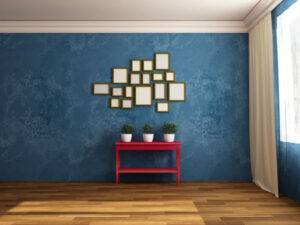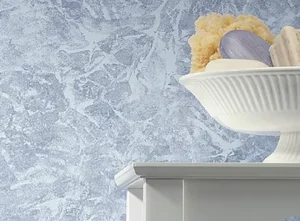
Of all the paint treatments that can be used, rag painting techniques are one of the most subtle and elegant and is the most useful in creating a number of different decorating looks for walls. Ragging creates a broken color technique, using thinned down paint or glaze and brushing it over a base coat, then using paper towels, rags or plastic trash bags while the paint is still damp, you rag some of it off to create a mottled or textured effect on the walls.
By changing the pressure that you use to press on the walls, or bunching and re-bunching the paper towels, you can make subtle variations in the patterns that are applied to the walls. The colors that you select will also greatly affect the end result.
Sponge Painting vs Rag Rolling
If you’re looking to understand the differences between sponge painting and rag rolling your walls, you might want to check this article out on rag painting techniques for sponge rag painting techniques for walls. Essentially it’s pretty obvious – the main difference is the materials you use. Here’s another guide to using texture when painting your walls.
The Best Rag Painting Techniques

Two shades of blue, as seen here, ragged over a white base coat for instance, will combine to create a very cool and cloudy looking finish, while if you instead, ragged paints such as off white over white, you would achieve a lovely elegant finish that reminds you of older parchment paper, and would look well with antique type decorating and achieve an elegant and luxurious look.
Experimentation is a large part of the fun in achieving the overall effect that you want. Whatever you do be certain that you use alkyd paints which has a far better translucence than the latex, that is dense in body and sometimes dries too quickly.. If you do select latex do thin it down a bit to prevent it from drying before you can rag effectively.
Materials You Will Need:
- Alkyd or latex primer
- Low lustre enamel paint for the ragging
- Low lustre paint for the base
- 2 3 inch paint brushes
- 4 or 5 rolls of paper towels
- 1 gallon odorless mineral spirits
- 2 large containers for paint mixing
- Plastic sheeting
- Masking tape.
Directions:
Spread plastic sheeting on your floors.
Mask off any woodwork or ceiling edging to prevent accidental ragging of it.
Keep your work area well ventilated, and prepare the walls with one coat of primer
Cover the wall with one coat of alkyd or latex base color, according to your manufactures directions and let it dry. Add a second coat and permit that to dry also.
Using a separate container, dilute the ragging colors with mineral spirits, mixing well until it is of the consistency of heavy cream.
Working in a 3 ft x3 ft area and beginning at the top of the walls, apply ragging colors from the bottom of the wall with brushes, alternating and overlapping the colors that you selected.
The ragging colors are applied with random brushstrokes so that the two shades overlapUse shorter strokes and go in random directions, being certain to cover the entire wall and don’t worry about the paint being messy looking. It is going to appear that way at first.
While the paint is still wet, wad up paper towels or rags and begin to press into the paint so that the base color will show through it.
Work from top to bottom of the walls, ragging from the edges of sections toward the middle so that the overlap won’t show through with thicker paint.
Re-wad your paper towels very frequently as paint build-up is going to take place, and when they become saturated, replace them. Finished sections will have a consistent look to them
Repeat the steps in 3—3 sections until all the walls are completed.
With wadded paper towels, the wet wall paint is ragged to create a mottled pattern
Basic Tips
Ragging is faster and much easier if you have an assistant to rag while you apply paint. If you do work alone, don’t attempt to do more than a 3—3 section because the paint will dry before you can rag it off.
If you are doing an entire room, do the opposite walls, then move to the other two opposite ones to prevent smudging in the corners.
Pile your paper towels close to the work area, already torn off to prevent having to go in search of them while your paint dries.

